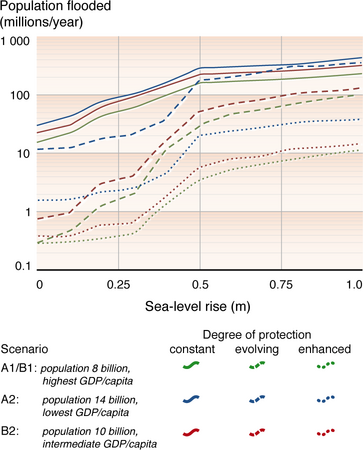
Figures marked "CSIRO", are copyright CSIRO, but please feel free to use them, conditional on the figures not being altered, and their source being acknowledged, and with a link to this site where possible. All other figures are copyright. Please do not copy without the owner's permission.
|
Sea level ImpactsSea levelSea level rise will be felt both through changes in mean sea level, and, perhaps more importantly, through changes in extreme sea level events. Even if there are no changes in extreme weather conditions (for example, increases in tropical cyclone intensity), sea level rise will result in extreme sea levels of a given value being exceeded more frequently. This change in the frequency of extreme events has already been observed at many locations. The increase in frequency of extreme events will depend on local conditions, but events that currently occur once every 100 years could occur as frequently as once every few years by 2100. Global Mean Sea Level increased by 210mm between 1880 and 2009, and is continuing to rise at a fairly steady rate of just over 3mm/year. This rate of rise is undoubtedly contributing to the flooding problems of low-lying island states like Tuvalu, Kiribati and the Maldives. This is exacerbated in some areas (e.g. Gippsland, Victoria and the Gulf coast of the U.S.) where large-scale land subsidence causes a rate of rise relative to the land which is substantially higher. Correspondingly, some areas have seen less impact because they are rising. Australia is rising at about 0.3-0.4mm/year due to Glacial Isostatic Adjustment (GIA), but is still starting to feel the effects. In addition, the continuing rise in mean level causes a corresponding increase in the frequency of extreme events, as detailed on the next page. Even without the increase in the frequency of extreme events, millions of people will be impacted by the direct effects of sea level rise over the next century as summarised in the next figure. Note that rises of .54 to .75 metres by the 2090s are well within the range of IPCC projections. Estimates of people flooded in coastal areas in the 2080s as a result of sea level rise and for given socio-economic scenarios and protection responses The large changes in sea level over the last few ice ages are sometimes used to dismiss the importance of the relatively small current changes in sea level, on the grounds (apparently) that mankind adapted to these changes in the past, so it should be able to adapt again. The obvious fallacy in this argument is that, previously, the inhabitants of a region would have picked up all of their worldy goods and gone somewhere more suitable when changes of sea level made their current habitat untenable. With the massive infrastructure (e.g. London and New York) that we have near sea level and the many millions of people living in threatened regions (e.g. Bangla Desh and southern Vietnam), such a solution is not available.
Sources: Nicholls, R.J. and Lowe, J.A. (2006) Climate stabilisation and impacts of sea level rise. In Avoiding Dangerous Climate Change (eds. H.J. Schellnhuber, W. Cramer, N. Nakicenovic, T.M.L. Wigley, and G. Yohe). Cambridge University Press, Cambridge. and Nicholls, R.J. and Tol, R.S.J. (2006). Impacts and responses to sealevel rise: a global analysis of the SRES scenarios over the twenty-first century. Philos. Trans. R. Soc. Lond. A, 364, 1073-1095 Source: UNEP: Global
outlook for Ice & Snow Estimates of people flooded in coastal areas in
the 2080s as a result of sea level rise and for given socio-economic scenarios
and protection responses. (June 2007). In UNEP/GRID-Arendal Maps and
Graphics Library. Retrieved 01:47, August 28, 2007 from http://maps.grida.no/go/graphic/estimates-of-people-flooded-in-coastal- The following web site and reports give more detailed indications of the impacts of sea level rise:
|
|
Website owner: Benoit Legresy | Last modified 4/03/11
|
![]()
